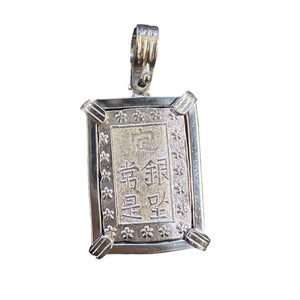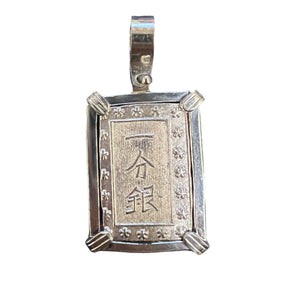Japan Samurai Coin - Ichibuban- Circa (1835-1865) Tempo Era
Sold Out
Region: Japan
Denomination: Ichibuban
Mint: Ginza
Mint Official: Joze
Date: Circa (1837-1854) Tempo Era
Metal: .21% gold, 98.86% silver
Mount: Sterling Silver
Weight: about 8 grams
Grade: Extra Fine
Description: Obverse Image: Incuse stamp (Jo) over 4 kanji in rectangle surrounded by 30 Sakura. Text: Romanization: / JOZE / GIN / ZA (Translation: Guaranteed Ginza (Silver Mint) Joze (Mint Official). Reverse: Three Kanji characters in a rectangle, surrounded by Sakura. Reverse Text: Romanization: ICHI / SHI / GIN (Translation: One Shu of silver). The edge of the coin has vertical reeding on the short side, along with slanted reeding on the long side.
History: Tokugawa coinage was a unitary and independent metallic monetary system established by Shōgun Tokugawa Ieyasu in 1601 in Japan, and which lasted throughout the Tokugawa period until its end in 1867. Tokugawa coinage worked according to a triple monetary standard, using gold, silver and bronze coins, each with their own denominations. The systems worked by multiples of 4, and coins were valued according to the Ryō. One Ryō was worth 4 Bu, 16 Shu, or 4,000 Mon (a cheap bronze coin).
Japan-42




